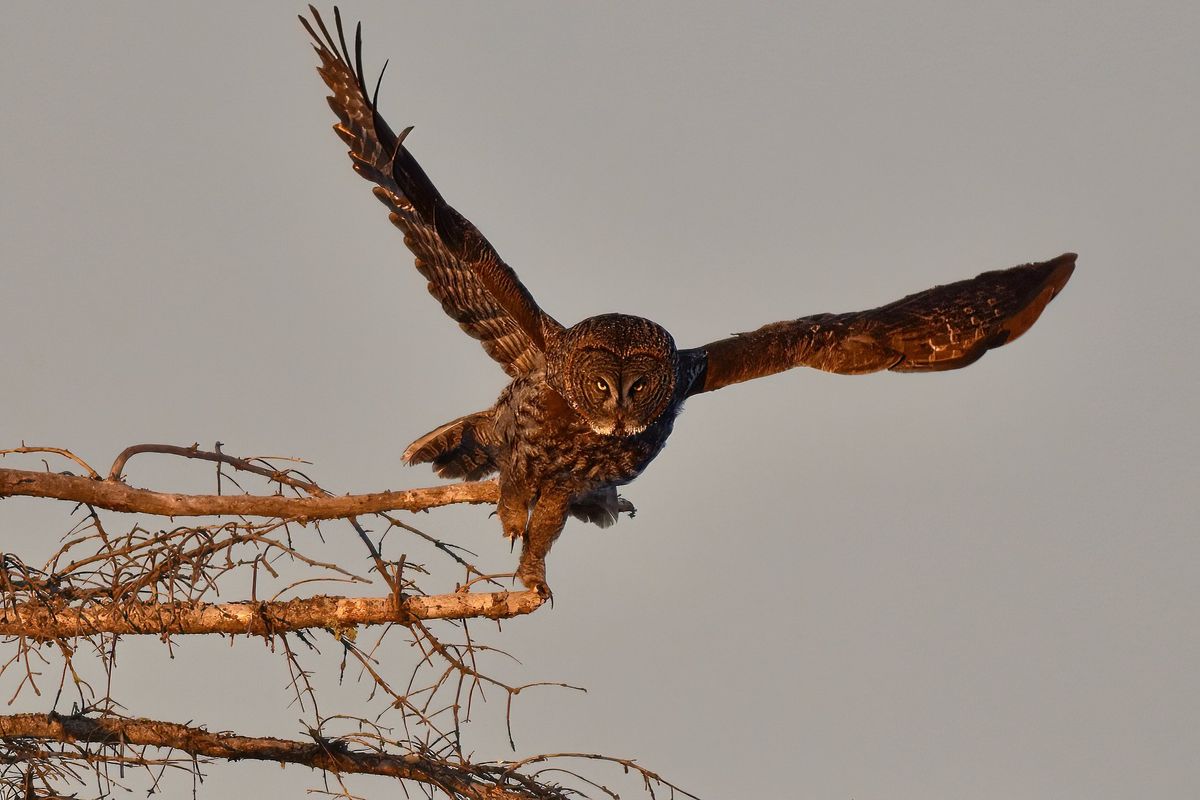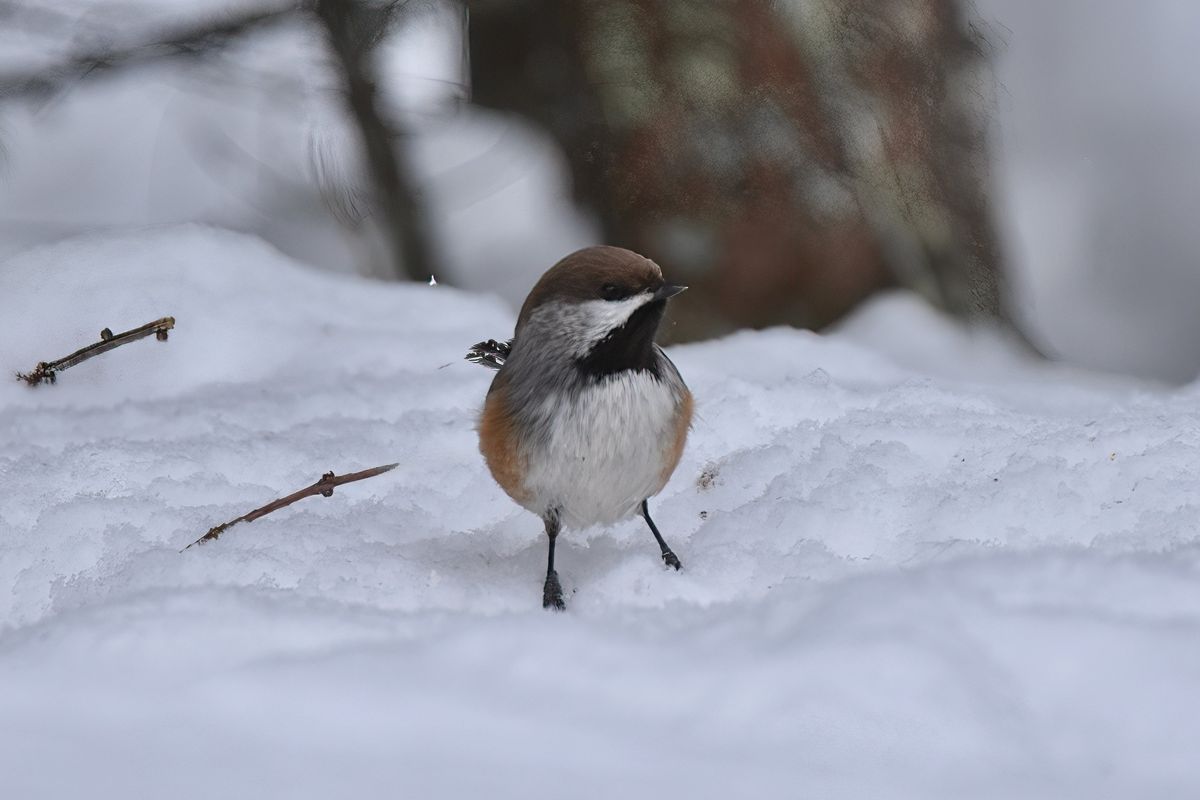Spokane wildlife photographer recounts her adventures in ‘bird nursery of America’

My fingers still ache from the icy-cold, while the Phantom of the North continues to warm my heart and I’m reminded that in wildlife photography one thing leads to another.
Last September while photographing whooping cranes at Horicon Marsh in Wisconsin, I had the pleasure of meeting some professional photographers eager to share other birding hot spots. New photographer friend Jim eagerly showed me owl photos that I could only dream of capturing. Jim told me where he took these photos, and I swore I heard him say something about sex in a bog. What? My mind revved with confusion. Spell that, please I asked. S-A-X-Z-I-M-B-O-G.
OK! My mind eased although I was still confused. Little did I know that Sax-Zim Bog in Minnesota would soon become a treasured place.
Fast forward to January.
While most travelers headed to the warm beaches of Mexico, I talked my partner into going to the exotic beaches of Lake Superior. Specifically, an hour north of Duluth, Minnesota, to Sax-Zim Bog, the coldest place in the country at the coldest time of the year, which unfortunately happens to be the time of year when the photographic goods are best.
Let’s just say wildlife photographers are driven. It’s a wacky hobby full of pursuit, endless searching and A LOT of waiting. Sometimes it is even worth it. This was one of those times.
With Jim’s owl photos emblazoned in my mind, I began my search in earnest, knowing that the two-day trip could be a total bust. Being outside is always a gain, but photographic success was hardly guaranteed.
My primary objective?

The Holy Grail of bird photography: The great gray owl, the most elusive bird species. It’s the most iconic boreal bird and the largest owl; however, this doesn’t make them easy to find.
“Phantoms of the North,” great grays are the sentinel of the boreal environment representing forests untouched. I longed to bring one home on my camera card, ideally punching into the deep snow. There was also word of a snowy owl in the area. Neither of which I had photographed in my year and a half of looking through the lens.
Gray wolves, pine martens, ermine, moose, boreal chickadees, sharp-tailed grouse, pine grosbeaks, white-winged crossbills, common and hoary redpolls, snow buntings and Bohemian waxwings were also high on my list.
SZB is a remote 300 square miles of boreal forest with a tiny visitor center run by volunteers. While there are a few trails, most visitors drive the country roads looking and looking and looking.
Approaching the SZB area from our Airbnb base of Duluth, my good sport and patient partner/driver would say, “Suit up,” and I’d be jumping out of the truck into the breath-catching bitter cold. Wearing battery-heated gloves, Smartwool, Ursa Minor Brewery souvenir beanie and four layers, I was ready. This is known as Brrrrrrrrrrrrding.
The boreal forests of SZB are a unique ecosystem, one of the last large forest areas that’s been untouched by humans.
“The boreal forest is this amazing exporter of birds that go all the way across the hemisphere and connect all the countries of the hemisphere,” said Jeff Well, the vice president of the Boreal Conservation National Audubon Society. “It is one of the last intact forest areas of the world … areas never before disturbed by large-scale human development of any kind.”
The forest starts in northern Maine and extends to Alaska. It’s also known as the Taiga and is the largest intact terrestrial biome on the planet. This is a magical mix of habitats: thick woods, sloping meadows and so many lakes.
Jeff explained how this is the bird nursery of North America given that 1-3 billion (yes, that is a ‘B’) birds breed across the boreal forest. Additionally, this biome is globally the world’s largest land-based carbon store, almost twice that of the tropical rain forests, giving great value to all of us, not just bird lovers.
Within 20 minutes of our arrival, we struck gold.
Better than gold, in fact.
A gorgeous snowy white owl adorned the top of a tall black spruce. We watched and waited for the takeoff. After a half hour of frigid fingers and shaky arms, I missed the much anticipated launch. These are moments, I reminded myself, I am simply fortunate to witness. She gave a show, diving head first into the snow for her supper, although she came up empty. Would I get another chance? Would she? I hoped so.
Not far from us, we saw some cars pulled off the road, a telltale sign of nearby birds.
Be still my beating heart … thee holy grail was before me again. A great gray owl fashioned in his bow tie looked down at us. Those piercing yellow eyes unlike anything I had seen. They cut into me in a way that still haunts me and makes me giggle at the same time.
While I stood outside holding my lens, two women with their Hubble Space Telescope-sized lenses told me it was their sixth year visiting the bog.
The great gray began to do exactly what we all hoped and started to hunt. Great grays hunt in the snow not by sight but by sound. They can hear a vole 2 feet under the snow 100 hundred yards away. Without any warning, they launch into the snow like torpedoes. It must be seen to be believed.
Once they hit the snow, head and talons first, they hover over the vole making sure it doesn’t get away. If I didn’t know what they were doing, I would think it was an injured owl. But then the great gray comes up with a prized vole and in one gulp, it’s down the hatch. More giggling and cheers of awe from the humans. Sorry, little vole.
The next two days proved bountiful.
A boreal chickadee, pine grosbeaks, white-winged crossbills, hoary and common redpolls and the snowy owl again. We just missed the next-highest want on my list, sharp-tailed grouse, while I was happy the woman from Milwaukee saw it for her Life List.
Next time.
Spring will send me back to see the migration with high hopes for Connecticut warblers (one of 20 returning warbler species), summer tanagers, common loons, butterflies, frogs, and Minnesota’s state flower, showy lady’s slippers or pink lady’s slipper, a native orchid. Thankfully, Friends of Sax-Zim Bog have given voice to this special place focusing on habitat preservation.
I am now officially a great gray groupie and a friend of SZB. It may be the lunar year of the Tiger, but for me it is the year of the Taiga.